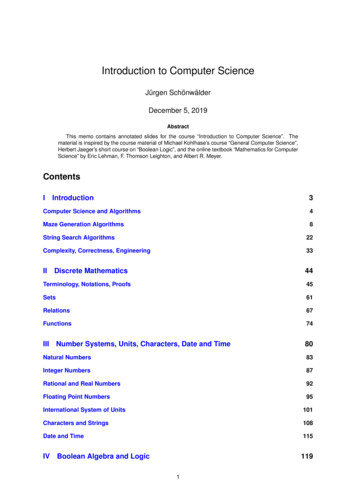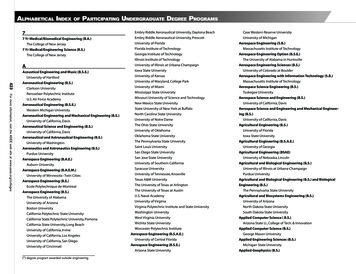
Transcription
D3 TutorialLayoutsEdit by Jiayi Xu and Han-Wei Shen, The Ohio State University
Layouts In essence, a layout function in D3 is just a JavaScript function that Takes your data as input Computes visual variables such as position and size to it so that we canvisualize the data
Pie – Pie Generator: d3.pie() Given an array of data, the pie generator computes the necessaryangles to represent the data Output an array of objects containing the original data augmentedby start and end angles which can be used to draw a pie chart by d3.arc() For example, we have an array of data Apply pie generator to the data to get arcData arcData:
Pie – Create a Pie Chart Data Fruits in the warehouse Create a pie generator to generate arcData Sort data by the name of fruits
Pie – Create a Pie Chart Create an arc generator to draw arcs of the pie chart
Stack – Stack Bars Stacked bar graphs segment their bars on top of each other. They are used to show how a larger category is divided into smallerseries/layers and what the relationship of each part has on the totalamountSeries/Layer 0Series/Layer 1Series /Layer 2
Stack – Create Stack Bars Data Daily sales of fruits: apricots, blueberries, and cherries. Define their colors
Stack – Create Stack Bars Series Three fruits Series 0: Apricots Series 1: Blueberries Series 2: Cherries Create a stack Generator Keys in generator are corresponding to keys in data
Stack – Create Stack Bars Series Three fruits Series 0: Apricots Series 1: Blueberries Series 2: Cherries Stack Generator The stack generator takes an array of multi-series (or multi-layer) data andgenerates an array for each series (or layer) where each array contains lower andupper values for each data point. The lower and upper values are computed so that each series (layer) is stacked ontop of the previous series (layer).
Stack – Create Stack Bars Apply generator to data, we get: stackGenerator(data) [ [ [0, 120],[0, 60],[0, 100],[0, 80],[0, 120] ],// Series 0: Apricots [ [120, 300], [60, 245], [100, 315],[80, 310],[120, 360] ], // Series 1: Blueberries [ [300, 400], [245, 350], [315, 425], [310, 415], [360, 465] ]// Series 2: Cherries ] Three arrays are the computeddata for three series Each array (series) has 5 tuples,which are lower and uppervalues for the bars of 5 daysSeries/Layer 0Mon Tue0060120Series/Layer 1Series /Layer 2Wed Thu0010080Fri0120245300315 310350400425 415360465
Stack – Create Stack Bars Create a g tag for each seriesg0g1g2
Stack – Create Stack Bars Remember, for each series (g tag), the datais an array computed by stackGenerator E.g. the computed data for series 0 (apricots) is [ [0, 120],[0, 60],[0, 100],[0, 80],[0, 120] ] Five tuples are corresponding to five days Create a rect element for each dayg0rect 1rect 0rect 2rect 3rect 4
Stack – Stream Graphs We can generate stream graphs with the help of area generator:d3.area()
Histogram Histograms bin many discrete samples into a smaller number ofconsecutive, non-overlapping intervals. They are often used to visualize the distribution of numerical data.
Histogram – Create a histogram Data Generate 1000 samples from the normal distribution d3.extent() can get the extent of the data, i.e., an array [min, max] of theminimum and maximum value of this data Histogram generator to create data of bins
Histogram – Create a histogram binsGenerator(data) Computes three attributes (length,x0, and x1) for the given arrayof data samples length the length of the bin is the number ofelements in that bin x0 The lower bound of the bin (inclusive) x1 the upper bound of the bin (exclusive,except for the last bin)
Histogram – Create a histogram Create scales x: map values to width y: map number of values in bins to height
Histogram – Create a histogram Draw bars and an axispadding
Chord Chord diagrams visualizelinks (or flows) between agroup of nodes, whereeach flow has a numericvalue. Example Migration flow betweenand within regions 2005 - 2010
Chord The data needs to be in the form of an n x n matrix (where n is thenumber of items) First row represents flows from the 1st item to the 1st, 2nd and 3rd items etc.10 2030406030080100200
Chord – Chord Generator: d3.chord() d3.chord() Compute startAngle and endAngle of each data item .padAngle(): set padding angle (gaps) between adjacent groups
Chord – Ribbon Generator: d3.ribbon() d3.ribbon() Converts the chord properties (startAngle and endAngle) into path data sothat we can draw chords by SVG .radius(): controls the radius of the final layout
Convex Hull In mathematics, the convex hull of a set of points in a Euclidean spaceis the smallest convex set that contains the points Application: Visualize different sets/clusters of points on the screen
Convex Hull Drawconvex hullby svg path Data We have some random points stored in avariable points d3.polygonHull(points) Generate the convex hull of the points Returns null if points has fewer than three elements The hull is represented as an array of theboundary points Arranged in counterclockwise order
Voronoi In mathematics, a Voronoi diagram is a partitioning of a plane intoregions based on distance to points in a specific subset of the plane Application: Partition a plane based on points
Voronoi – d3.voronoi() Data Generate coordinates of 20 pointsrandomly
Voronoi – d3.voronoi() d3.voronoi() Computes the Voronoi diagram for the specified data points .extent() Take the extent of the screen
Voronoi – d3.voronoi() Draw cell boundaries voronoiGenerator.polygons(points) Returns coordinates of the polygon whichencloses each point renderCell is a function to transformcoordinates to path data of SVG
Given an array of data, the pie generator computes the necessary angles to represent the data Output an array of objects containing the original data augmented bystartandend angles which can be used to draw a pie chart by d3.arc() For example, we have an array of data Apply pie generator to the datato get arcData arcData:










